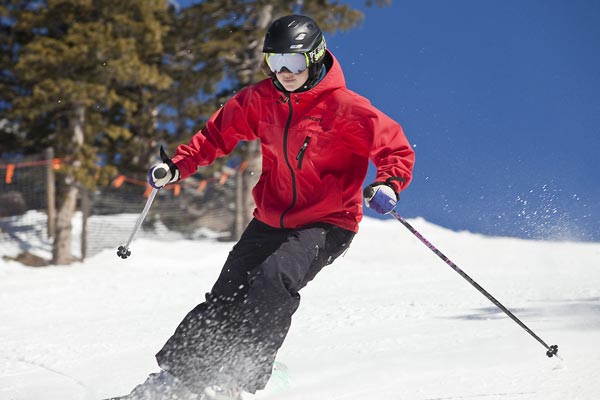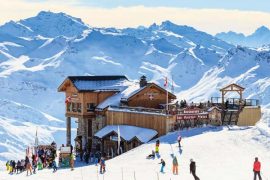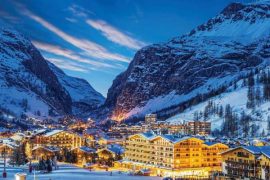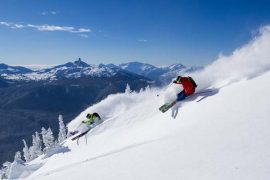Many people have dreams of flying. But do you ever have dreams of skiing? Many people who ski either recreationally or professionally say that dreams of skiing are much more fun! But did you know that there are several different types of skiing?
Skiing is a national past time that many people enjoy. Thousands of people flock to the Vale and Aspen, Colorado ski resorts each year in search of the slopes. Why? Because skiing is a unique and exhilarating sport that is coveted by many people.
You get to don ski sweaters and protective eyewear and head down some of the most impressive (and intimidating) mountains in the Rockies or wherever you have decided to call home during the busy ski season.
One of the finer aspects of skiing is that you get to choose where you stay. With hundreds of different ski lodges to choose from across the country, you are likely to find somewhere to hang your ski cap.
If you are interested in skiing, you may be interested to know that there are almost as many different types of skiing as there are places to ski.
In this post, we’ll take a look at 12 of the most popular kinds of skiing that you can indulge in when you are in a skiing mood.
Types of Skiing
Which one are you? Read about the different kinds of skiing and see which one fits your level of bravery!
1. Alpine Skiing
According to Team USA, Alpine skiing is also known as downhill skiing, and it is considered the traditional type of skiing.
To engage in alpine skiing, skiers must learn to work their body and shift it to the left and right as they descend to avoid falling.
There are fixed-heel bindings so that your feet remain in place, which differs from other types of skiing which use free-heel bindings.
People come from miles around to see alpine skiing competitions, and they are held everywhere from Norway to Colorado every year.
2. Cross-country skiing
This type of skiing involves skiing that requires the skier to move using only their own body movement. They do not use traditional ski lifts or other forms of transportation assistance to get there.
Many people think that cross-country skiing means to traverse across the entire country where you live. While this is an interesting goal, it is doubtful that many would be able to achieve this in one lifetime!
3. Freestyle skiing
According to Olympic news, Freestyle skiing is a type of skiing that attempts to combine all of the finer points of skiing into one. It also combines speed and the ability to do aerial stunts while skiing, which gives it a higher level of showmanship.
Freestyle skiing first debuted as a demonstration sport during the 1988 Calgary Games. It caught on in other areas around the world after that, and it is not considered a staple type of ski event that many want to take part in.
4. Ski Jumping
Ski Jumping is a skiing sport that allows competitors to attempt to achieve the longest jump possible after descending from a ramp that is designed specifically for that purpose at the end of a ski run.
During an official ski jumping competition, skiers are judged based on the length of their jump, as well as their unique style, and other factors that affect their final score. Norway first introduced ski jumping in the late 19th century.
The popularity of ski jumping increased over the years and appeared in Europe and North America in the early 20th century. It utilizes the Nordic skiing techniques in addition to the rules and practices of cross-country skiing.
Ski jumpers often focus on practicing their jump while neglecting the other aspects of their technique. But, to be good enough for the Olympics, every aspect of your routine must be worked on, no matter how long it takes.
5. Ski cross
According to the Winter Olympics Association, Ski cross is a type of skiing that qualifies for a timed racing event.
It is often a part of freestyle ski competitions due to its ability to allow for skiing on unique terrain and other aspects that are found in freestyle skiing.
When people speak about ski cross, they are usually talking about the competition, and it is not considered a style of skiing as much as it is a competition.
You will often see the ski cross at any skiing event that you attend, even local or regional tournaments.
6. Speed skiing
Speed skiing, as its name implies, features a type of skiing that is based on skiing down a long ski slope in a straight line as fast as possible. It is a timed race and is often featured at famous ski competitions.
A world record in speed skiing was broken recently in speed skiing when Ivan Origone broke his brother’s record and set a new milestone of 254,958 km/h.
These mind-boggling speeds are achieved by focusing on pulling one’s body in and hoping that you did not get on an obstacle course instead!
7. Slopestyle
Slopestyle skiing is a type of skiing that features a course that includes obstacles that skiers must maneuver around while they descend the slope, which is often curved and erratic. There are often many jumps that must be achieved and other terrain challenges.
Skiers earn points for successfully doing the jumps, clearing the various obstacles, and doing a variety of original tricks and maneuvers as they make their way through the track.
This is a challenging type of skiing and requires that the skier is always alert so that you will not encounter obstacles that make you lose your balance.
8. Snowboarding
According to NBC Olympics Association, Snowboarding is not a normal type of skiing. In fact, many argue that it is not skiing at all. But it does use all of the traditional features of skiing. The difference is that it uses one big board, rather than two skis.
To snowboard, the rider stands on a snowboard attached to their feet (similar to a skateboard or surfboard) and they maneuver down the ski slope on the board.
When you are hurling through the snow on a snowboard, there’s no time for thought, just motion.
9. Water Skiing
Water skiing is different from the other types of skiing because it is done during the hottest of summer months, rather than the coldest of winter months as regular winter skiing is done.
It is considered a water sport and involves a person being pulled behind a speedboat.
To water ski successfully, the rider must maintain their balance as they go through the waves and turns that the boat creates in front of them without falling off.
For this reason, it is essential that the boat maintain a certain speed so that the skier will be able to keep their constant speed and balance.
Many famous movies feature skiing, and it has become a favorite water sport, especially in coastal towns where you can ski on the open ocean.
10. Biathlon
Biathlon is a winter sport that uses maneuvers and styles that are borrowed from both cross-country skiing and rifle shooting.
Contestants must attempt to shoot at a designated target while skiing without falling, which can reduce their overall score.
The biathlon is a timed race and the contestants with the best time winning the contest. It is believed that its origins come from Scandinavia, where ancient Scandinavians participated in the event to laud the gods of the hunt and the god of skiing.
11. Nordic combined
Nordic combined skiing involves a competition that combines cross-country skiing and ski jumping. This type of winter sport is often seen at the Winter Olympics, and it is often featured as a top event.
People who compete in this tough-guy type of skiing event are often seen as real “macho men.” That’s because it takes a great deal of strength and endurance, as you can see if you watch the video.
12. Luge
The Luge is a unique type of “skiing” that involves a person lies down flat on the surface of a small sled with their feet in front of the sled.
They must steer with their calf muscles as they descend the course and exert pressure to the seat to continue to remain mobile.
This is a tricky type of skiing, but it appeals to those who enjoy sledding or other snowboard types of activities.
You may see this type of competition at skiing competitions, no matter where you are as it is quite popular.
Watch this video that features the Luge up close and personal!
You will notice that skiers using this type of technique must glide down on the ice and make their body as “aerodynamic as possible” to increase their speed.
What do these ski types have in common?
These ski types are all unique in their way. Some involve a particular technique, while others allow for more creativity in routine such as with the freestyle skiing method.
But one thing they all have in common is the fact that each type of skiing can be seen in the Winter Olympics and they all involve a high level of athletic skill and strength that consists in maneuvering their body in a variety of ways to stay on track.
How to Get Started with Skiing Yourself
Now that you have learned all of the different types of skiing that they do in the Winter Olympics, you may be inspired to take a flying leap off a slope yourself. But not so fast!
These athletes who compete in these types of skiing events are highly skilled and experienced in their chosen sport, and they have taken years of training to get there.
Skiing is dangerous for the average person, and you should do your homework on the proper gear and other preliminary equipment that you’ll need before you head for the slopes.
You’ll also want to look into where to ski. If this is your first time out, you will need to work up to it gradually and start small before you are ready to take on the Swiss Alps.
Skiing for the Beginner
If you want to play it safe, you could start out by trying out a ski school at first until you get used to the idea and the terrain. This online ski course takes it a step at a time, starting with sliding on snow. Check it out and see what you think.
Who is best for skiing?
It’s a simple fact of life that some people are better at some sports than others. Some of this is determination and natural talent. But there are also physical characteristics that are involved when it comes to a sport like skiing.
For example, you would not want to invest in skiing as a sport if you have a balance problem.
Older adults or people with a problem with balance or equilibrium will be less likely to keep their balance on the slopes.
Use good judgment when it comes to your skiing ambitions if you have these issues.
The Joy of Skiing
Once you decide that skiing is right for you, start slow and build on your skills. Set small goals for yourself, beginning with balancing on the snow, moving back and forth over the snow, and increasing your goals as you gain skills.
Control is a big part of skiing so the more you can learn to control your movements, the more you will be able to control your results.
Practice makes perfect so remember to be patient and don’t try to become an Olympic gold medalist overnight.
People love to ski for different reasons, but most report that it gives them the most exhilarating feeling of freedom of any sport that they have ever tried. If you think you have what it takes, go for it!
See you on the slopes!




